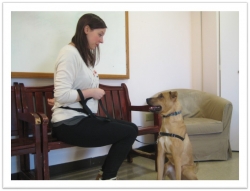
Courtney Chandler—a dog trainer and behavioral science nerd—shares the secret to how she and her husband hacked their relationship and found harmony while adjusting to being together 24-7.
—
With large portions of the country under stay-at-home orders, we’re discovering that quarantines tend to make folks irritable with the people around them. This is a completely understandable reaction. After all, we’re facing a public health crisis and economic instability, all while we don’t have access to many of our typical coping mechanisms: gyms, social gatherings, public entertainment.
Of course, we’re irritable! But, if left unchecked, that irritability could easily take on a life of its own, becoming a self-perpetuating cycle of unpleasantness, a feed-back loop of hurt and anger.
I’ve been there, and I used my dog training know-how to develop a tool that helped my husband and I reclaim harmony. I call it, “radical gratitude.”
—
Nearly 6 years ago, after my husband and I moved to Denver, we suddenly found ourselves inhabiting the same small space 24-7, with only each other for company. Eventually we noticed that we were sniping at each other, a lot, and we didn’t really understand why. We talked about needing more social outlets and stress relief. We acknowledged that being home together, all day, was bound to put us into conflict more often. And yet, it didn’t get better.
So I sat down and put on my dog trainer’s cap, metaphorically speaking. I started thinking about the problem from a behavioral standpoint. It sounds a bit silly to use dog training to fix a marital problem, but learning theory (the foundation of modern science-based dog training) can be used to understand and adjust most animal behavior, including in humans.
In dog training, we tell our clients to focus on what their dog is doing right. We ask our clients to look for any and every opportunity to reward their dog for doing something they like. This reshapes the mind of both the dog and the human, while strengthening the bond between the two. The dog’s mind is reshaped because they are literally being rewarded for certain choices, which makes the dog more likely to repeat those choices again in the future. The human’s mind is reshaped because, instead of focusing on what the dog is doing wrong, the human now becomes focused on what the dog is doing right. In changing the human’s focus, they’re able to appreciate how much their dog is getting right, and the slip-ups seem less important. Finally, it strengthens the bond between human and dog, by engendering strong positive mental associations with each other. Shifting the focus from what’s wrong to what’s right, also shifts the underlying dynamic from tension to harmony, because dog and human are motivated to work with each other instead of against each other.
I thought about this cornerstone of dog training, and I thought about what my husband and I had been doing. We’d been fixating on all the things we felt the other person was doing wrong: a plate left on the counter, a text that didn’t get a timely response, etc. The question remained, how could we change it? It’s not like I could just feed my husband a cookie every time he did something I liked. Nevertheless, we needed to start looking for what we liked in each other, and that’s when the answer came to me: gratitude.
Don’t get me wrong. We already thanked each other regularly, but our thanks-yous were reflexive, mechanical almost. We had to do better. We had to really feel our gratitude. We had to experience our gratitude almost viscerally. We had to share our gratitude in genuine and heartfelt ways. And we had to be grateful for more than just the most obvious of things.
My husband and I talked through my idea, which I dubbed “radical gratitude,” and started implementing it right away. When I said ‘thank you,’ I made the point of making eye contact and smiling. His thank-yous often came coupled with a complement. We looked for every excuse, no matter how small to thank each other. And it started working almost immediately. We quickly started feeling happier and more comfortable with each other. The sniping and squabbling diminished practically overnight, and were replaced with affection and openness. Just as our irritability had been, our gratitude became self-perpetuating.
In focusing on being grateful for each other, not only were we engendering more positive feelings in our relationship, we were also incidentally training each other to do more nice things. We felt happier doing things to take care of the other person, or even clean up after the other person. Of course, we still irked each other sometimes, but annoyances were short lived.
The change probably sounds more dramatic than it was. I’m sure we would have found other ways to stop bickering. Nonetheless, it felt transformative. We had hacked our relationship using the fundamentals of behavior science.
—
So what exactly is radical gratitude? While others before me have probably used this term in their own ways, here’s what I mean when I say radical gratitude:
Conscious, proactive gratitude for every good thing, large or small.
Radical gratitude is a way to reframe our thoughts and feelings, so we can fully appreciate the good in our lives. This reframing is accomplished by consciously feeling our gratitude and then expressing it genuinely. It should be expressed, even if only to ourselves. However, in sharing our gratitude, it can also improve the experiences of those around us.
Radical gratitude is NOT, however, a way to make difficult feelings go away, and it absolutely should not be used to silence anyone expressing “negative” feelings or experiences. Radical gratitude also does not mean we should force ourselves to be grateful for even our challenges. Finally, radical gratitude probably won’t fix broken relationships; it may however encourage harmony in relationships that are facing hardship.
—
Which brings me back to the problem at hand. With the spread of this pandemic, millions of people have found themselves in circumstances similar to those that led to my own feedback loop of bickering. As such, it seems like a good time to share this relationship hack.
If you want to try it, here are some steps for implementing radical gratitude in a relationship:
Step 1: Look for any good thing, big or small, that someone does/says/is.
Step 2: Take a moment to really appreciate the action/sentiment/trait. Recognize that good thing as a gift. Try to feel your gratitude in your body. Notice where you feel it. Maybe it’s in your stomach, or chest, or somewhere else entirely.
Step 3: Express your gratitude genuinely. Try to find a way to convey your gratitude so the other person truly feels it.
Step 4: Repeat with intention.
That last step is really important. It’s not enough to keep saying thank you, you have to keep consciously engaging in the practice. The whole process gets faster and easier over time. Gratitude is like a muscle, and before I started consciously exercising it, my gratitude muscle was kind of pathetic. Now, I can tap into it with ease, and use gratitude as a tool for reframing my thoughts and feelings about many things in my life.
While radical gratitude is not a panacea for all life’s ills, it could be a valuable tool in facing isolation and confinement. There’s only one way to find out.
—
If you’re interested in learning more about the science of practicing gratitude, you can read about it here and here.




